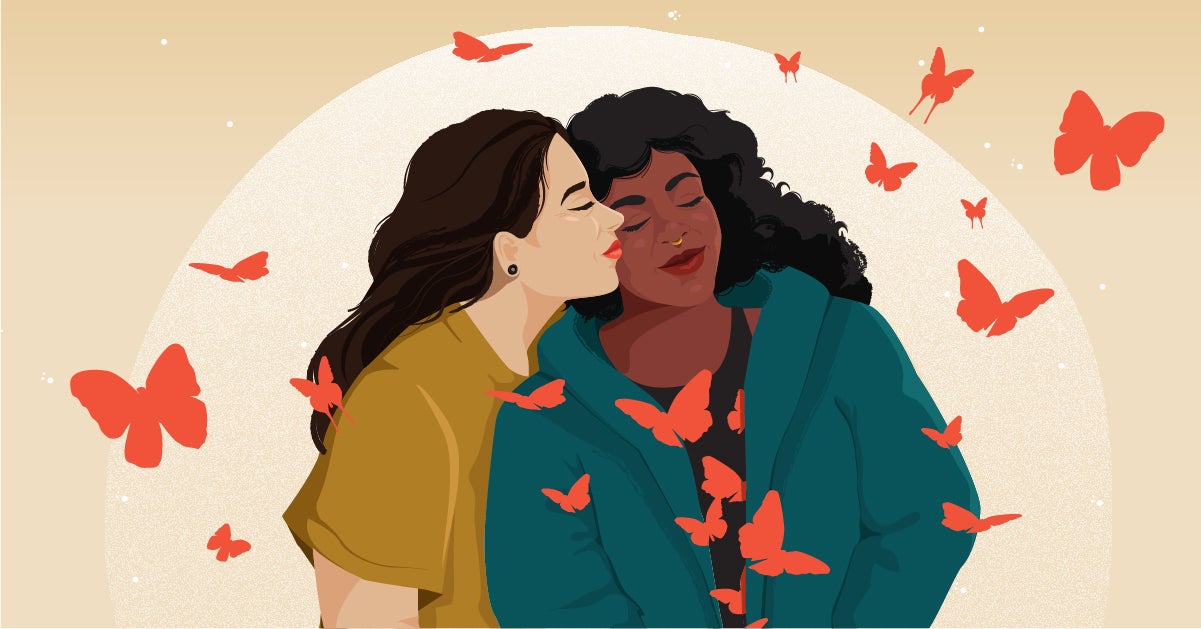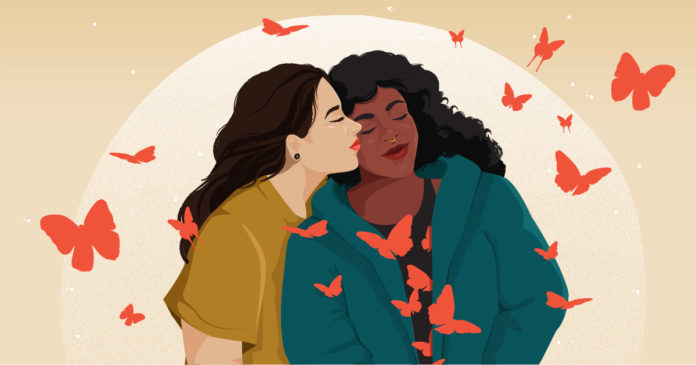
Heya, queer folks!
Question for you: Have you ever felt behind? Like your straight, cisgender friends have more romantic, relational, or sexual experience than you?
This feeling of “behind-ness” may be connected to something known as the “second queer adolescence.”
Here, gender and sexuality educators explain what a second queer adolescence is, the joys and lows of it, as well as how to embrace your personal timeline no matter your age or the timelines of those around you.
The gist behind second queer adolescence is that queer people live their “teenage years” twice.
First, living out the identities we’re told we should embody. (And suppressing or coming to terms with our queer identities.)
Then, as our queer selves.
“The idea of a second queer adolescence is that queer people don’t have access to meeting certain developmental ‘milestones’ until after they’ve come out as queer,” explains certified sex therapist and queer person Casey Tanner, MA, LCPC, expert for luxury pleasure product company LELO.
Even the concept of “developmental milestones” is rooted in compulsory heterosexuality.
“When we talk about the developmental milestones we associate with adolescence, we’re talking about them around the timeline of when our straight, cisgender peers have the privilege of experiencing them,” Tanner says.
These so-called ~developmental milestones~ range from everything from our first kiss (with someone we’re actually attracted to) and first relationship (with someone we actually have the potential to experience deep feelings for) to first feeling comfortable dressing as ourselves and identifying with the media we’re consuming, she says.
“This time might be the first that a queer person has access to a friend group who shares their identities and can celebrate those milestones with them,” Tanner says.
The short answer: all the -isms and -phobias.
“Homophobic and heteronormative, transphobic, and cisnormative narratives, as well as governmental policies and cultural norms in religion, families, schools, social spaces, laws, and various other institutions, all contribute to people suppressing or fearing their sexualities and sexual orientations,” says Jesse Kahn, LCSW, CST, director and sex therapist at The Gender & Sexuality Therapy Center in New York City.
Starting from birth, young queer folks learn from their caregivers that straight, gender-conforming behavior will be rewarded while queer or gender-nonconforming behavior will be punished, notes Tanner.
Sometimes this messaging is super explicit. For instance, a young boy being told that enjoying theater “is gay.”
And sometimes it’s more subtle. Like not allowing a kid to dress the way they’d like because it feels a little too “flamboyant,” or asking a teenage girl if there are any boys she has a crush on (rather than asking her if there’s anyone she likes).
Your age may affect just how much (or how little) LGBTQIA+ representation you witnessed in movies and TV shows growing up.
In 2009, queer characters were present in some way, shape, or form in just 3 percent of all regular characters in scripted series airing on ABC, CBS, The CW, Fox, and NBC.
But they were present in 22 — that’s 18.6 percent — of 118 films produced by major studios in 2019.
In other words, the younger you are, the more queer representation you may have had.
But for most people reading this, there was a significant lack of LGBTQIA+ representation in the media they consumed growing up, says Kahn.
“And a lack of queer representation in the media contributes to shame,” he says.
It also leads to a lack of what Tanner calls “social mirroring.”
When queer people don’t see experiences like their own reflected back to them in adolescence, “it communicates that queerness does not exist at all, or that if it does, it’s something to be avoided rather than celebrated,” they say.
The lack of media representation also contributes to LGBTQIA+ people *not* encountering the language that best names their lived experience(s) as a gendered (or nongendered), sexual (or asexual) being in the world until much later in life.
“With no language or examples to help queer folks put words to what they’re feeling, they often try to adapt to their straight peers because that’s the representation that’s readily available,” Tanner says.
“There’s not one right path, nor one linear path, to being open and living openly in your queerness,” Kahn says.
Nor is there one right path for your relationship(s) to take, if you choose to enter any.
However, toxic monogamy — the cultural belief that happy, healthy relationships all look the same — contributes to the idea that there is.
One of the forces of toxic monogamy is this thing called the “relationship escalator.” Coined by Amy Gahran, the relationship escalator says that all (legitimate) relationships follow the same trajectory:
Dating → property purchasing→ holy matrimony → child rearing → till death do us part.
Taking these steps in this order isn’t inherently bad, but the pressure society puts on every single relationship to take those steps is, says queer psychotherapist and sex and relationship expert Rachel Wright, LMFT.
In short, that’s because it often makes people feel like they’re romantically “behind” if they haven’t had a relationship, or made it the last step (e.g., marriage) by, like, 30…
To be clear: This is true for people all across the sexuality spectrum.
The idea that you’re “behind” because you’re learning your gender and sexuality later in life than cis-het folks totally underestimates how much self-awareness the process of coming into your gender and sexuality as a non-cis, non-het person really takes.
“Often the process of coming out (later in life) propels queer people into a place of self-awareness and exploration that some cis straight folks never choose to pursue,” Tanner says.
“It’s not about being ahead or behind, but rather creating a life worth living for you, wherever you are,” she says.
“It’s more than OK to spend some time grieving that you didn’t get the support you needed when you were young,” Tanner says. These tips can help.
Find your people
“There’s a whole online community of folks who call themselves ‘late bloomers’ who are embracing coming out later in life,” Tanner says.
Depending on when you came out, you might decide to find them, befriend them, and share your experiences.
Follow queer people on social media
Consuming media of people who look like you and have had similar gender and sexuality journeys as you can be tremendously helpful, says Wright.
But, she says, “do so in an intentional way, because it’s incredibly easy to consume media that validates the yucky thoughts of behind-ness.”
Celebrate yourself!
Don’t stop yourself from celebrating important “firsts” or milestones because of your age.
Allow yourself to gush over first kisses and go out to queer bars even if you feel “too old.” Enjoy anniversaries, throw “The L Word” watch parties, and host ~fashion shows~ with your friends on FaceTime.
“If you’re struggling to find community, find a queer therapist who can celebrate with you until you do,” Tanner says.
Ask for help if you need it
“If you’re struggling to embrace your sexuality but want to feel more at home in your sexuality, consider what beliefs are inhibiting you,” Kahn says.
“It can take work to unlearn our internalized homophobia and transphobia, and it’s important to reflect on, unlearn, and challenge what beliefs are still thriving inside of you,” they say.
If that’s not work you feel you can do on your own, seek out the care of a queer-informed therapist or queer support group.
When a tweet that popularized the term “second queer adolescence” went viral in 2017, Brianna Suslovic, LMSW, wrote a response on Medium noting that while she agrees with the tweet’s premise, it’s important that LGBTQIA+ people don’t use it as an excuse to treat others poorly.
“‘Mistakes’ that are made by adolescents and LGBTQ folks often cause hurt, harm, and rupture within relationships and communities,” she writes.
“While these ‘mistakes’ may be more understandable as ways of working through the things that adolescents typically work through, they are still not exempt from accountability.”
Her concern? That harm-doers will misuse the concept of a second queer adolescence to justify immaturity, recklessness, and harm-doing, all while evading the possibility of holding perpetrators of this harm accountable.
So, as Kahn puts it, “it’s important to remember that while you may be in a second adolescence, you’re not actually an adolescent, so the consequences of your choices and behaviors will be adult consequences.”
And likewise, harm is still harm, even if it was executed unintentionally or during a moment of self-exploration.
So, if you do harm someone else, take accountability.
No matter when you came out — be it to yourself or those around you — or when you got the opportunity to experience the “firsts” typically associated with adolescence, you’re exactly where you need to be.
Gabrielle Kassel is a New York-based sex and wellness writer and CrossFit Level 1 Trainer. She’s become a morning person, tested over 200 vibrators, and eaten, drunk, and brushed with charcoal — all in the name of journalism. In her free time, she can be found reading self-help books and romance novels, bench-pressing, or pole dancing. Follow her on Instagram.








